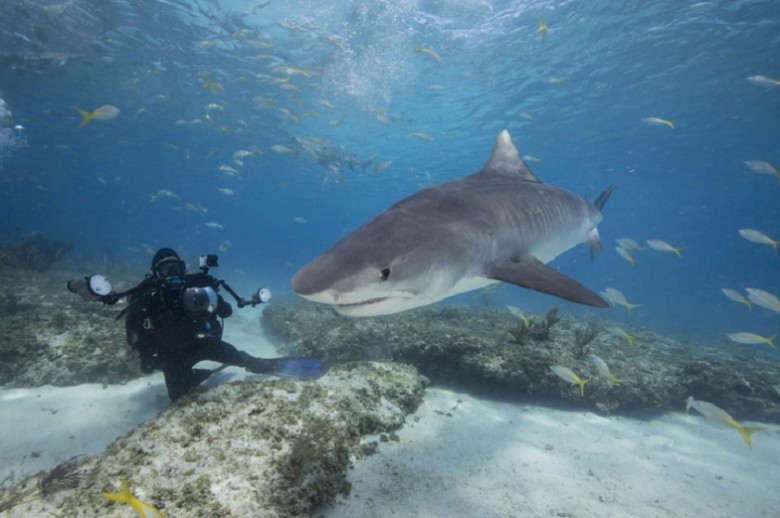
Myths and Truths About Sharks
The ocean is both a captivating and intimidating realm, home to a diverse array of creatures. Among them, the shark stands as one of the most enigmatic and misunderstood denizens of the deep. Some say they are harmless unless provoked, while others claim they are dangerous predators with an insatiable appetite for human blood. The truth, as is often the case, lies somewhere in between these polarizing perspectives.

Let's dive into the myths and truths surrounding these enigmatic sea dwellers, shedding light on their remarkable biology, behaviors, and the crucial role they play in the delicate balance of marine ecosystems.
Myth: All sharks are large and dangerous.
The reality is far more nuanced. Of the more than 500 shark species found worldwide, the vast majority are relatively small, harmless creatures that pose no threat to humans.

In fact, the average size of a shark is just 3-4 feet long, with the majority of species measuring less than 6 feet. The notorious great white shark, often portrayed as a relentless man-eater, is an outlier, typically reaching lengths of 15-20 feet.
Truth: Sharks have a highly developed sense of smell.
One of the sharks' most extraordinary abilities is their acute sense of smell. Capable of detecting a single drop of blood in millions of parts of water, sharks use their olfactory senses to track down and locate their prey.

This skill is particularly impressive when one considers that sharks can detect prey from distances of up to a mile away. This evolutionary adaptation has allowed sharks to thrive as apex predators in the vast ocean environment.
Myth: Sharks can swim backwards.
This common misconception stems from the shark's impressive maneuverability in the water. However, the truth is that sharks cannot swim backwards due to the structure of their fins. Unlike many other fish species, sharks must constantly move forward to ensure proper water flow over their gills, enabling them to breathe.

While they may appear to be swimming backward momentarily, their fins and body shape prevent them from maintaining that motion for any extended period.
Truth: Sharks play a crucial role in the marine ecosystem.
Far from being mindless killers, sharks are essential components of the delicate balance that sustains the ocean's biodiversity. As top predators, they help maintain the health of marine populations by selectively eliminating weaker, diseased, or injured individuals.

This process ensures the overall resilience of the ecosystem, allowing it to thrive. Without the presence of sharks, the intricate web of life in the ocean would unravel, with far-reaching consequences for the entire marine environment.
Myth: Sharks are immune to cancer.
This persistent myth has been thoroughly debunked by scientific research. While cancer rates are indeed lower in sharks compared to many other vertebrates, it is not accurate to state that they are entirely immune to this disease.

Researchers have documented various forms of cancer in shark populations, including cartilage and liver cancers. The belief that sharks are "cancer-proof" likely stems from their robust immune systems and rapid cellular regeneration, but these adaptations do not confer complete immunity.
Truth: Sharks can perceive electric fields.
One of the sharks' most remarkable abilities is their capacity to detect and respond to the faint electric fields generated by their prey. This skill is made possible by the Lorenzinian ampoules, specialized sensory organs located in the shark's head.

These ampullae allow sharks to locate and zero in on their targets, even in murky or dark waters where other senses may be impaired. This unique adaptation gives sharks a significant advantage in hunting and navigating their environment.
Myth: Sharks have no natural enemies.
While the shark may be the apex predator in many marine ecosystems, it is not entirely free from natural threats. Young sharks, in particular, can fall victim to larger sharks, as well as other formidable predators such as killer whales.

Adult sharks, too, can face attacks from their own kind, with larger specimens sometimes preying on smaller sharks. This intricate web of predator-prey relationships is a testament to the dynamic and ever-evolving nature of the ocean's food chain.
Truth: Some sharks can live in freshwater.
Despite being primarily adapted to the saltwater environment, certain shark species have the remarkable ability to thrive in freshwater as well. The bull shark, for instance, is known to venture up rivers and estuaries, able to osmoregulate and adjust its internal chemistry to accommodate the lower salinity levels.

This remarkable versatility allows these sharks to expand their range and explore new habitats, further demonstrating the incredible adaptability of these marine predators.
Myth: Sharks need to swim constantly to survive.
While it is true that many shark species must maintain constant forward motion to ensure proper water flow over their gills, allowing them to breathe, this is not the case for all sharks.

Some species, such as the nurse shark, have specially adapted gills that enable them to pump water over their respiratory organs while remaining stationary. This allows these sharks to rest on the seafloor, conserving energy and reducing the need for continuous swimming.
Truth: Shark teeth are constantly growing.
Sharks are renowned for their impressive dentition, with some species capable of losing and replacing thousands of teeth over the course of their lifetimes. This remarkable ability is made possible by the shark's unique dental structure, which features rows of teeth that continually grow and replace older, worn-down ones.

As a shark loses a tooth, another from the same row will move forward to take its place, ensuring the apex predator maintains a formidable set of razor-sharp tools for hunting and feeding.
Myth: Sharks only eat meat.
While sharks are undoubtedly carnivorous predators, feeding primarily on fish, marine mammals, and other smaller ocean creatures, there is evidence that some shark species have been observed consuming plant matter as well.

Studies have revealed that certain shark species, such as the bonnethead shark, have been known to supplement their diet with seagrass and other vegetation. This unexpected dietary flexibility highlights the adaptability and diverse feeding strategies employed by these remarkable animals.
Truth: Sharks are an ancient species.
Sharks have been roaming the world's oceans for hundreds of millions of years, with the earliest known shark fossils dating back over 400 million years. This makes sharks one of the oldest surviving vertebrate species on the planet, predating the emergence of most dinosaurs.

This longevity is a testament to the sharks' evolutionary success, as they have continued to thrive and adapt to the changing marine environments over the course of geological eras.
Myth: Shark attacks are very common.
Despite the media's sensationalized portrayal of shark attacks, the reality is that these incidents are exceedingly rare. In fact, a person is more likely to be struck by lightning than to be attacked by a shark.

According to the International Shark Attack File, the annual global average of unprovoked shark attacks is just 70-100 incidents, with only a handful resulting in fatalities. This puts the risk of a shark attack into perspective, highlighting the misconceptions often perpetuated about the true danger these animals pose to humans.
Truth: Sharks have incredibly tough skin.
The shark's skin is more than just a protective layer – it is a remarkable example of evolutionary engineering. Covered in tiny, tooth-like structures called denticles, the shark's skin is incredibly tough and abrasion-resistant. These denticles not only provide defense against predators but also help reduce drag and improve the shark's hydrodynamic efficiency as it swims. This unique adaptation has contributed to the shark's success as a dominant predator in the ocean, allowing them to thrive in a wide range of aquatic environments.

As we delve deeper into the myths and truths surrounding sharks, it becomes clear that these marine predators are far more complex and fascinating than the one-dimensional caricatures often portrayed in popular culture. From their highly developed senses and hunting strategies to their crucial role in maintaining the delicate balance of the ocean's ecosystems, sharks are truly remarkable creatures worthy of our respect and fascination.
By dispelling common misconceptions and shedding light on the scientific realities of shark biology and behavior, we can foster a greater understanding and appreciation for these apex predators. This knowledge, in turn, can inform more effective conservation efforts and help us coexist more harmoniously with these enigmatic denizens of the deep.

So, the next time you hear a shark-related myth, take a moment to reflect on the truths that lie beneath the surface. For in doing so, we can gain a deeper appreciation for the wonders of the natural world and the incredible diversity of life that thrives in the vast, mysterious oceans that cover our planet.




















Comments
0 comment